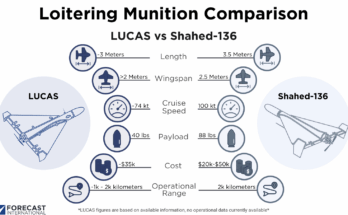 Source: U.S. Air Force
Source: U.S. Air ForceThe Pentagon is undertaking a sweeping review of military spending that could potentially realign tens of billions of dollars per year to higher-priority programs. The effort, spearheaded by Defense Secretary Pete Hegseth, seeks to find reductions totaling approximately 8% of the Pentagon’s budget annually over the next five years. The intention is not to necessarily reduce the overall size of the defense budget. Instead, the review aims to cut spending on bureaucracy and lower-priority programs to reinvest in capabilities seen by the current administration as critical for future conflicts.
Reshaping the Defense Landscape
A statement from Acting Deputy Defense Secretary Robert Salesses confirmed the initiative would reallocate $50 billion in fiscal year 2026. Technically that figure represents closer to 6% of the $876.8 billion defense budget projected under the Biden administration. The exact target may shift from year-to-year, but the review could aim to reprogram between $250 billion and $350 billion over the next five years.
It’s typical for new administration to review and modify budget plans from the outgoing president, but this effort represents the largest review of defense spending since the Budget Control Act (BCA) of 2011, which erased hundreds of billions of dollars of planned budget growth over the course of a decade. During those years of constrained spending, the services worked to identify efficiencies and savings to keep their modernization priorities alive. The scale of this new initiative suggests substantial programmatic changes may be required, potentially impacting major acquisition programs and overall force structure.
The review is also separate from a pending assessment of defense expenditures by Elon Musk’s Department of Government Efficiency (DOGE) team. The two efforts could run in parallel to identify areas for potential reductions, but it’s unclear if DOGE would recommend cutting the defense topline.
What’s on the Chopping Block?
One of the primary targets for cuts is “excessive bureaucracy,” according to Salesses. While the specifics have yet to be determined, this category could include reductions in the civilian workforce, a decrease in the number of generals, and other sweeping personnel changes. Additionally, climate change initiatives and diversity, equity, and inclusion (DEI) programs will be targeted. The DoD won’t find $50 billion worth of cuts in FY26 from these programs alone, meaning larger reductions in other areas of the budget are expected.
In a memo outlining the review, Hegseth listed 17 exemptions from cuts, signaling the Pentagon’s plan to protect key modernization priorities. Among the protected systems are collaborative combat aircraft, Virginia class submarines, loitering munitions and autonomous systems, nuclear modernization, homeland missile defense, counter small-unmanned aerial systems, munitions, and certain cybersecurity programs. The list also includes “executable funding for surface ships,” but it’s unclear what that means for the Constellation class frigate that was specifically called out by Trump for its growing costs. Also protected from cuts are operations impacting Southwest border security, as well as support funding for Indo-Pacific Command, Northern Command, Space Command, Strategic Command, Cyber Command, and Transportation Command. Not only are these areas safe from cuts, but they likely also represent where much of the funding cuts identified in the pending review will be reinvested.
Notably absent from the list of exemptions are several high-profile programs, raising speculation that they could be impacted by the review. The F-35 fighter, which has been criticized by Musk during a time of an increased focus on drones, was not marked safe. Similarly, the future crewed Next-Generation Air Dominance (NGAD) fighter, combat vehicles, and some regional commands – including European Command and Central Command – were not explicitly protected from potential cuts.
Congressional Battles and Budget Uncertainty
Any changes put forward by the administration will need approval from Congress. Lawmakers, who can recommend program-level adjustments during the annual budget markup process, could put up roadblocks against acquisition or force structure adjustments that impact their districts. For example, Congress has regularly stepped in to prevent legacy equipment from being retired, like the A-10, Global Hawk, and a mix of Navy warships. Lawmakers have also saved programs from termination in the past, such as the Navy’s Nuclear Sea-Launched Cruise Missile, and they often step in to increase procurement rates for items like aircraft, combat vehicles, and warships.
Outside of the pending review, Congressional Republicans are working on reconciliation legislation that would let them pass an array of federal tax cuts and spending adjustments with a simple majority in the Senate, rather than the 60-vote threshold required for regular spending bills. Separate reconciliation efforts in the House and Senate are currently proposing an additional $100 billion and $150 billion, respectively, for the Pentagon over 10 years. The proposals would increase defense spending by between 1.1 and 1.7 percent annually. It’s unclear exactly where this additional money would go if it materialized, but it could be used to further bolster some of the Pentagon’s highest priority projects or save certain programs from the chopping block. Congress will also retain the ability to further increase or modify the annual defense budget request via the regular appropriations process.
Senate Armed Services Committee Chairman Roger Wicker (R-Miss.) and his counterpart in the House, Rep. Mike Rogers (R-Ala.), have recommended increasing the defense budget beyond the levels currently being debated in the reconciliation bills. Wicker proposed adding up to $200 billion for the Pentagon over two years, while Rogers suggested the U.S. should be spending 4% of GDP on defense, which would push the Pentagon’s budget over the $1 trillion mark. Outgoing Defense Secretary Lloyd Austin also recommended adding $50 billion to the FY26 national security budget, which would have brought total spending to $926.5 billion.
Mixed Signals
Meanwhile, President Trump, who campaigned on a platform of increasing military investment, recently floated the idea of slashing the defense budget in half as part of a potential future agreement with China and Russia. He also suggested that the U.S. doesn’t need to procure additional nuclear weapons, even though nuclear modernization is a top priority for the Pentagon. It’s questionable if Moscow or Beijing would be willing to curtail their own defense budgets, especially since the U.S. maintains such a large funding advantage. China maintains that the U.S. would have to take the lead on spending cuts and nuclear disarmament with Russia before Beijing would consider discussing such topics. Trump’s comments on nuclear disarmament are also disconnected to his push for a massive missile defense shield to cover the U.S. While a 50% defense budget cut is widely considered unlikely, Trump’s conflicting statements have injected unpredictability into the debate. That sense of uncertainty bolstered by the fact that Trump’s first term ended with flat defense budget projections, despite actions earlier the term that initially increased defense outlays.
With so much happening at once, the timing of the FY26 budget process is uncertain. The federal budget request is typically released in early February but delays often occur when Congress doesn’t complete budget work from the previous year on time or when a new administration enters the White House. The Pentagon faces both of those factors this year. Lawmakers have yet to wrap up FY25 budget negotiations, meaning Pentagon budget planners don’t know how much money they’ll receive in FY25 as the FY26 budget review takes place. The FY26 request could ultimately be delayed by months. As the budget process moves forward, the outcome of this review could shape the Pentagon’s strategic direction for years to come. Whether the effort leads to genuine efficiency gains or provokes political battles over spending priorities remains to be seen, but it’s clear the debate over how the U.S. funds its military is far from over.
Shaun's deep-rooted interest in military equipment continues in his role as a senior defense analyst with a focus on the United States. He played an integral role in the development of Forecast International's U.S. Defense Budget Forecast, an interactive online product that tracks Pentagon acquisition programs throughout the congressional budget process. As editor of International Military Markets – North America, Shaun has cultivated a deep understanding of the vast defense markets in the United States and Canada. He is a regular contributor to Forecast International's Defense & Security Monitor blog and has co-authored white papers on global defense spending and various military programs.
image sources
- 13th CABS conducts first CSTR event at Ft. Bliss: U.S. Air Force




